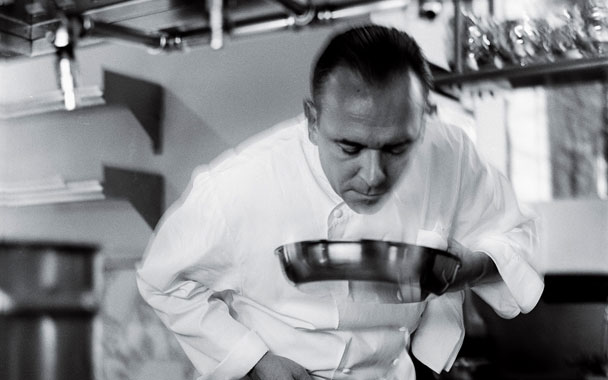I was the first customer for the new Jean Georges Culinary Master Course, a one-hour session with Vongerichten himself, part of a package that includes a park-view suite in the same hotel as his namesake restaurant. (Price tag: a cool $9,000—an all-or-nothing deal.) In the chrome-clad kitchen, sparkly in the morning light, I would have been happy to do nothing but play with the toys—turning on the many stoves to see their high-rising flames, whirring all the blenders, maybe peeking into a cabinet or two while chatting with the other chefs, now easing into a lunchtime prep. The kitchen was large, as you’d expect, and more open than most. You could see all the way across the dining room to a wall that framed Central Park like a mural painted on glass. The scene was distracting, the mood mellow. We were both at ease. Before us on the counter sat a massive hunk of dark red tuna, the size of a small roast, and Jean-Georges, the master of French-Asian technique, was ready. “Shall we get started?” he said.
After making deep parallel slices across the top of the fish, as if it was a loaf of bread, he cut each slab into half-inch noodles—square noodles—and then took me over to a stove, where I watched him prepare a ginger purée with Champagne vinegar, soy sauce, and Kaffir lime syrup. He showed me how to make a chile-oil marinade, with minced Thai chiles, anchos, chipotles, and a handful of other ingredients, also to be assembled for the plate of tartare. Finally, he pulled the entire dish together with the artistry of a magician but slowly enough so that I, a mere mortal, could take in every step. “Incredible,” I said, after tasting the heavenly concoction. And I thought: “Now I can do that.”
As Jean-Georges made a vinaigrette with Banyuls vinegar, soy sauce, and lemon juice for the black sea bass, right before toasting hazelnuts, almonds, coriander seeds, and peppercorns for a crust, I thought: “Yes, I can do that.” After he carefully assembled egg yolks on toast and doused them with caviar, I thought: “I can do that.” By the time we got to the “gently smoked” squab à l’orange, I felt more like the exuberant dancer from A Chorus Line than a lucky writer.
It helped that Jean-Georges provided cheat-sheet menus and suffered through my questions. (“What if I can’t find Banyuls vinegar?” “Use Sherry,” he said.) Everything was logical, easy to understand, with one curious exception that caught me off guard. After sticking an ordinary cake tester into a piece of grilling sea bass, he extracted the pin and touched it to the area just below his lip. It was an odd sight, and I had to ask: “What are you doing?” He seemed surprised that anyone would notice: “Checking to see if it’s done,” he said. “When the tip feels warm—not hot—the fish comes out.” My curiosity must have earned some kind of instant respect. He grabbed a passing busboy and sent him off to the pantry for a new pin. It came encased in plastic, like something from the Dollar Store. I knew I would treasure it.




 Pinterest
Pinterest






